The concept and future prospects of soil health
Soil health is the continued capacity of soil to function as a vital living ecosystem that sustains plants, animals and humans, and connects agricultural and soil science to policy, stakeholder needs and sustainable supply-chain management. Historically, soil assessments focused on crop production, but, today, soil health also includes the role of soil in water quality, climate change and human health. However, quantifying soil health is still dominated by chemical indicators, despite growing appreciation of the importance of soil biodiversity, owing to limited functional knowledge and lack of effective methods. In this Perspective, the definition and history of soil health are described and compared with other soil concepts. We outline ecosystem services provided by soils, the indicators used to measure soil functionality and their integration into informative soil-health indices. Scientists should embrace soil health as an overarching principle that contributes to sustainability goals, rather than only a property to measure.
This is a preview of subscription content, access via your institution
Access options
Access Nature and 54 other Nature Portfolio journals
Get Nature+, our best-value online-access subscription
cancel any time
Subscribe to this journal
Receive 12 digital issues and online access to articles
133,45 € per year
only 11,12 € per issue
Buy this article
- Purchase on SpringerLink
- Instant access to full article PDF
Prices may be subject to local taxes which are calculated during checkout
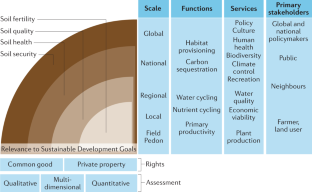

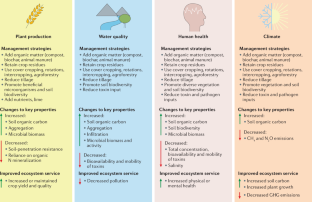
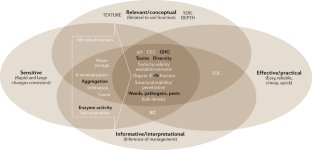
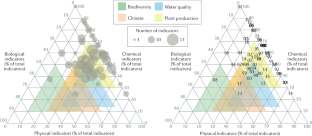
Similar content being viewed by others
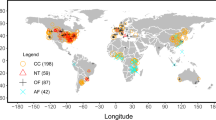
A database for global soil health assessment
Article Open access 13 January 2020
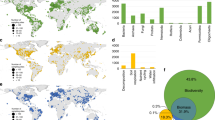
Blind spots in global soil biodiversity and ecosystem function research
Article Open access 03 August 2020
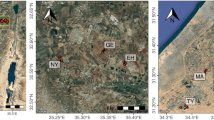
A sensitive soil biological indicator to changes in land-use in regions with Mediterranean climate
Article Open access 23 December 2022
References
- Ladyman, J., Lambert, J. & Wiesner, K. What is a complex system? Eur. J. Philos. Sci.3, 33–67 (2013). Google Scholar
- Brevik, E. C. et al. The interdisciplinary nature of SOIL. Soil1, 117–129 (2015). Google Scholar
- Blum, W. E. Functions of soil for society and the environment. Rev. Environ. Sci. Biotechnol.4, 75–79 (2005). Google Scholar
- Baveye, P. C., Baveye, J. & Gowdy, J. Soil “ecosystem” services and natural capital: critical appraisal of research on uncertain ground. Front. Environ. Sci.4, 41 (2016). Google Scholar
- Keith, A. M., Schmidt, O. & McMahon, B. J. Soil stewardship as a nexus between ecosystem services and one health. Ecosyst. Serv.17, 40–42 (2016). Google Scholar
- Bünemann, E. K. et al. Soil quality–a critical review. Soil Biol. Biochem.120, 105–125 (2018). Google Scholar
- Patzel, N., Sticher, H. & Karlen, D. L. Soil fertility - phenomenon and concept. J. Plant Nutr. Soil Sci.163, 129–142 (2000). Google Scholar
- Doran, J. W. & Parkin, T. B. in Defining Soil Quality for a Sustainable Environment Vol. 32 (eds Doran, J. W., Coleman, D. C., Bezdicek, D. F. & Stewart, B. A.) 1–21 (Soil Science Society of America, 1994).
- Pankhurst, C. E., Doube, B. M. & Gupta, V. V. S. R. in Biological Indicators of Soil Health (eds Pankhurst, C., Doube, B. & Gupta, V.) 419–435 (CAB International, 1997).
- McBratney, A., Field, D. J. & Koch, A. The dimensions of soil security. Geoderma213, 203–213 (2014). Google Scholar
- Koch, A. et al. Soil security: solving the global soil crisis. Glob. Policy4, 434–441 (2013). Google Scholar
- Stankovics, P., Tóth, G. & Tóth, Z. Identifying gaps between the legislative tools of soil protection in the EU member states for a common European soil protection legislation. Sustainability10, 2886 (2018). Google Scholar
- Montanarella, L. Agricultural policy: govern our soils. Nature528, 32–33 (2015). Google Scholar
- Jian, J., Du, X. & Stewart, R. D. A database for global soil health assessment. Sci. Data7, 16 (2020). Google Scholar
- Karlen, D. L., Veum, K. S., Sudduth, K. A., Obrycki, J. F. & Nunes, M. R. Soil health assessment: past accomplishments, current activities, and future opportunities. Soil Tillage Res.195, 104365 (2019). Google Scholar
- Norris, C. E. & Congreves, K. A. Alternative management practices improve soil health indices in intensive vegetable cropping systems: a review. Front. Environ. Sci.6, 50 (2018). Google Scholar
- O’Dell, R. E. & Claassen, V. P. Vertical distribution of organic amendment influences the rooting depth of revegetation species on barren, subgrade serpentine substrate. Plant Soil285, 19–29 (2006). Google Scholar
- Congreves, K. A., Hayes, A., Verhallen, E. A. & Van Eerd, L. L. Long-term impact of tillage and crop rotation on soil health at four temperate agroecosystems. Soil Tillage Res.152, 17–28 (2015). Google Scholar
- Hamza, M. A. & Anderson, W. K. Soil compaction in cropping systems: a review of the nature, causes and possible solutions. Soil Tillage Res.82, 121–145 (2005). Google Scholar
- Jenkinson, D. S. The Rothamsted long-term experiments: Are they still of use? Agron. J.83, 2–10 (1991). Google Scholar
- Berendsen, R. L., Pieterse, C. M. & Bakker, P. A. The rhizosphere microbiome and plant health. Trends Plant Sci.17, 478–486 (2012). Google Scholar
- Chaparro, J. M., Sheflin, A. M., Manter, D. K. & Vivanco, J. M. Manipulating the soil microbiome to increase soil health and plant fertility. Biol. Fertil. Soils48, 489–499 (2012). Google Scholar
- Bonanomi, G., Lorito, M., Vinale, F. & Woo, S. L. Organic amendments, beneficial microbes, and soil microbiota: toward a unified framework for disease suppression. Annu. Rev. Phytopathol.56, 1–20 (2018). Google Scholar
- Chen, X. D. et al. Soil biodiversity and biogeochemical function in managed ecosystems. Soil Res.58, 1–20 (2020). Google Scholar
- Pittelkow, C. M. et al. Productivity limits and potentials of the principles of conservation agriculture. Nature517, 365–368 (2015). Google Scholar
- Ogle, S. M., Swan, A. & Paustian, K. No-till management impacts on crop productivity, carbon input and soil carbon sequestration. Agric. Ecosyst. Environ.149, 37–49 (2012). Google Scholar
- Zimnicki, T. et al. On quantifying water quality benefits of healthy soils. BioScience70, 343–352 (2020). Google Scholar
- Evans, A. E., Mateo-Sagasta, J., Qadir, M., Boelee, E. & Ippolito, A. Agricultural water pollution: key knowledge gaps and research needs. Curr. Opin. Environ. Sustain.36, 20–27 (2019). Google Scholar
- Carpenter, S. R. et al. Nonpoint pollution of surface waters with phosphorus and nitrogen. Ecol. Appl.8, 559–568 (1998). Google Scholar
- Lamichhane, S., Krishna, K. B. & Sarukkalige, R. Polycyclic aromatic hydrocarbons (PAHs) removal by sorption: a review. Chemosphere148, 336–353 (2016). Google Scholar
- Tournebize, J., Chaumont, C. & Mander, Ü. Implications for constructed wetlands to mitigate nitrate and pesticide pollution in agricultural drained watersheds. Ecol. Eng.103, 415–425 (2017). Google Scholar
- Hanson, J. R., Macalady, J. L., Harris, D. & Scow, K. M. Linking toluene degradation with specific microbial populations in soil. Appl. Environ. Microbiol.65, 5403–5408 (1999). Google Scholar
- Li, G., Sun, G. X., Ren, Y., Luo, X. S. & Zhu, Y. G. Urban soil and human health: a review. Eur. J. Soil Sci.69, 196–215 (2018). Google Scholar
- Laurenson, G., Laurenson, S., Bolan, N., Beecham, S. & Clark, I. The role of bioretention systems in the treatment of stormwater. Adv. Agron.120, 223–274 (2013). Google Scholar
- Wagg, C., Bender, S. F., Widmer, F. & van der Heijden, M. G. Soil biodiversity and soil community composition determine ecosystem multifunctionality. Proc. Natl Acad. Sci. USA111, 5266–5270 (2014). Google Scholar
- Kadam, A. M., Oza, G. H., Nemade, P. D. & Shankar, H. S. Pathogen removal from municipal wastewater in constructed soil filter. Ecol. Eng.33, 37–44 (2008). Google Scholar
- Welch, R. M. & Graham, R. D. Breeding for micronutrients in staple food crops from a human nutrition perspective. J. Exp. Bot.55, 353–364 (2004). Google Scholar
- Barrett, C. B. & Bevis, L. E. The self-reinforcing feedback between low soil fertility and chronic poverty. Nat. Geosci.8, 907–912 (2015). Google Scholar
- Wood, S. A., Tirfessa, D. & Baudron, F. Soil organic matter underlies crop nutritional quality and productivity in smallholder agriculture. Agric. Ecosyst. Environ.266, 100–108 (2018). Google Scholar
- Wall, D. H., Nielsen, U. N. & Six, J. Soil biodiversity and human health. Nature528, 69–76 (2015). Google Scholar
- Jacoby, R., Peukert, M., Succurro, A., Koprivova, A. & Kopriva, S. The role of soil microorganisms in plant mineral nutrition—current knowledge and future directions. Front. Plant Sci.8, 1617 (2017). Google Scholar
- Schlatter, D., Kinkel, L., Thomashow, L., Weller, D. & Paulitz, T. Disease suppressive soils: new insights from the soil microbiome. Phytopathology107, 1284–1297 (2017). Google Scholar
- Rillig, M. C., Lehmann, A., Lehmann, J., Camenzind, T. & Rauh, C. Soil biodiversity effects from field to fork. Trends Plant Sci.23, 17–24 (2018). Google Scholar
- Oliver, M. A. & Gregory, P. J. Soil, food security and human health: a review. Eur. J. Soil Sci.66, 257–276 (2015). Google Scholar
- Hussein, H. S. & Brasel, J. M. Toxicity, metabolism, and impact of mycotoxins on humans and animals. Toxicology167, 101–134 (2001). Google Scholar
- Bethony, J. et al. Soil-transmitted helminth infections: ascariasis, trichuriasis, and hookworm. Lancet367, 1521–1532 (2006). Google Scholar
- Schatz, A., Bugle, E. & Waksman, S. A. Streptomycin, a substance exhibiting antibiotic activity against gram-positive and gram-negative bacteria. Proc. Soc. Exp. Biol. Med.55, 66–69 (1944). Google Scholar
- Ling, L. L. et al. A new antibiotic kills pathogens without detectable resistance. Nature517, 455–459 (2015). Google Scholar
- Veresoglou, S. D., Halley, J. M. & Rillig, M. C. Extinction risk of soil biota. Nat. Commun.6, 8862 (2015). Google Scholar
- Lal, R. Soil carbon sequestration impacts on global climate change and food security. Science304, 1623–1627 (2004). Google Scholar
- Paustian, K. et al. Climate-smart soils. Nature532, 49–57 (2016). Google Scholar
- Denef, K. & Six, J. Clay mineralogy determines the importance of biological versus abiotic processes for macroaggregate formation and stabilization. Eur. J. Soil Sci.56, 469–479 (2005). Google Scholar
- Rinot, O., Levy, G. J., Steinberger, Y., Svoray, T. & Eshel, G. Soil health assessment: A critical review of current methodologies and a proposed new approach. Sci. Total. Environ.648, 1484–1491 (2019). Google Scholar
- Van Wesemael, B. et al. An indicator for organic matter dynamics in temperate agricultural soils. Agric. Ecosyst. Environ.274, 62–75 (2019). Google Scholar
- Bouma, J. et al. in Global Soil Security (eds Field, D. J., Morgan, C. L. S. & McBratney, A. B.) 27–44 (Springer, 2017).
- Schoenholtz, S. H., Van Miegroet, H. & Burger, J. A. A review of chemical and physical properties as indicators of forest soil quality: challenges and opportunities. For. Ecol. Manag.138, 335–356 (2000). Google Scholar
- Andrews, S. S. & Carroll, C. R. Designing a soil quality assessment tool for sustainable agroecosystem management. Ecol. Appl.11, 1573–1585 (2001). Google Scholar
- Lilburne, L. R., Hewitt, A. E., Sparling, G. P. & Selvarajah, N. Soil quality in New Zealand: policy and the science response. J. Environ. Qual.31, 1768–1773 (2002). Google Scholar
- Idowu, O. J. et al. Use of an integrative soil health test for evaluation of soil management impacts. Renew. Agric. Food Syst.24, 214–224 (2009). Google Scholar
- Cherubin, M. R. et al. A Soil Management Assessment Framework (SMAF) evaluation of Brazilian sugarcane expansion on soil quality. Soil Sci. Soc. Am. J.80, 215–226 (2016). Google Scholar
- E.U. Mission Board Soil Health and Food. Caring for Soil is Caring for Life. The Publications Office of the European Unionhttps://op.europa.eu/en/web/eu-law-and-publications/publication-detail/-/publication/32d5d312-b689-11ea-bb7a-01aa75ed71a1 (European Commission, 2020).
- Nunes, M. R., Karlen, D. L., Veum, K. S., Moorman, T. B. & Cambardella, C. A. Biological soil health indicators respond to tillage intensity: a US meta-analysis. Geoderma369, 114335 (2020). Google Scholar
- Kaiser, E. A. et al. Nitrous oxide release from arable soil: importance of N-fertilization, crops and temporal variation. Soil Biol. Biochem.30, 1553–1563 (1998). Google Scholar
- Baldock, J. A., Beare, M. H., Curtin, D. & Hawke, B. Stocks, composition and vulnerability to loss of soil organic carbon predicted using mid-infrared spectroscopy. Soil Res.56, 468–480 (2018). Google Scholar
- Rossel, R. V. et al. Continental-scale soil carbon composition and vulnerability modulated by regional environmental controls. Nat. Geosci.12, 547–552 (2019). Google Scholar
- Six, J., Bossuyt, H., Degryze, S. & Denef, K. A history of research on the link between (micro)aggregates, soil biota, and soil organic matter dynamics. Soil Tillage Res.79, 7–31 (2004). Google Scholar
- Pietrelli, A., Bavasso, I., Lovecchio, N., Ferrara, V. & Allard, B. in 8th IEEE International Workshop on Advances in Sensors and Interfaces (IWASI) 302–306 (IEEE, 2019).
- Shaikh, F. K. & Zeadally, S. Energy harvesting in wireless sensor networks: a comprehensive review. Renew. Sustain. Energy Rev.55, 1041–1054 (2016). Google Scholar
- Tan, X., Sun, Z., Wang, P. & Sun, Y. Environment-aware localization for wireless sensor networks using magnetic induction. Ad Hoc Netw.98, 102030 (2020). Google Scholar
- Lehmann, J. et al. Persistence of soil organic carbon caused by functional complexity. Nat. Geosci.13, 529–534 (2020). Google Scholar
- Tedersoo, L. et al. Global diversity and geography of soil fungi. Science346, 1078 (2014). Google Scholar
- Van Den Hoogen, J. et al. Soil nematode abundance and functional group composition at a global scale. Nature572, 194–198 (2019). Google Scholar
- Rillig, M. C., Bonneval, K. & Lehmann, J. Sounds of soil: a new world of interactions under our feet? Soil Syst.3, 45 (2019). Google Scholar
- Smolka, M. et al. A mobile lab-on-a-chip device for on-site soil nutrient analysis. Precision Agric.18, 152–168 (2017). Google Scholar
- Rossel, R. A. V. & Bouma, J. Soil sensing: a new paradigm for agriculture. Agric. Syst.148, 71–74 (2016). Google Scholar
- Ali, M. A., Dong, L., Dhau, J., Khosla, A. & Kaushik, A. Perspective — electrochemical sensors for soil quality assessment. J. Electrochem. Soc.167, 037550 (2020). Google Scholar
- Enell, A. et al. Combining leaching and passive sampling to measure the mobility and distribution between porewater, DOC, and colloids of native oxy-PAHs, N-PACs, and PAHs in historically contaminated soil. Environ. Sci. Technol.50, 11797–11805 (2016). Google Scholar
- Sismaet, H. J. & Goluch, E. D. Electrochemical probes of microbial community behaviour. Annu. Rev. Anal. Chem.11, 441–461 (2018). Google Scholar
- Chabrillat, S. et al. Imaging spectroscopy for soil mapping and monitoring. Surv. Geophys.40, 361–399 (2019). Google Scholar
- Mohanty, B. P., Cosh, M. H., Lakshmi, V. & Montzka, C. Soil moisture remote sensing: state-of-the-science. Vadose Zone J.16, 1–9 (2017). Google Scholar
- Paustian, K. et al. Quantifying carbon for agricultural soil management: from the current status toward a global soil information system. Carbon Manage.10, 567–587 (2019). Google Scholar
- Duckett, T. et al. Agricultural robotics: the future of robotic agriculture. Preprint arXivhttps://arxiv.org/abs/1806.06762 (2018).
- Hussain, I., Olson, K. R., Wander, M. M. & Karlen, D. L. Adaptation of soil quality indices and application to three tillage systems in southern Illinois. Soil Tillage Res.50, 237–249 (1999). Google Scholar
- Fine, A. K., van Es, H. M. & Schindelbeck, R. R. Statistics, scoring functions, and regional analysis of a comprehensive soil health database. Soil Sci. Soc. Am. J.81, 589–601 (2017). Google Scholar
- Svoray, T., Hassid, I., Atkinson, P. M., Moebius-Clune, B. N. & van Es, H. M. Mapping soil health over large agriculturally important areas. Soil Sci. Soc. Am. J.79, 1420–1434 (2015). Google Scholar
- Moebius-Clune, B. N. et al. Comprehensive Assessment of Soil Health – The Cornell Framework, Edition 3.1 (Cornell Univ. Press, 2016).
- Wiesmeier, M. et al. Soil organic carbon storage as a key function of soils-a review of drivers and indicators at various scales. Geoderma333, 149–162 (2019). Google Scholar
- Lima, A. C. R., Brussaard, L., Totola, M. R., Hoogmoed, W. B. & de Goede, R. G. M. A functional evaluation of three indicator sets for assessing soil quality. Appl. Soil Ecol.64, 194–200 (2013). Google Scholar
- Verheijen, F. G., Bellamy, P. H., Kibblewhite, M. G. & Gaunt, J. L. Organic carbon ranges in arable soils of England and Wales. Soil Use Manage.21, 2–9 (2005). Google Scholar
- Bucka, F. B., Kölbl, A., Uteau, D., Peth, S. & Kögel-Knabner, I. Organic matter input determines structure development and aggregate formation in artificial soils. Geoderma354, 113881 (2019). Google Scholar
- Kaiser, K. et al. Driving forces of soil bacterial community structure, diversity, and function in temperate grasslands and forests. Sci. Rep.6, 33696 (2016). Google Scholar
- Jordan-Meille, L. et al. An overview of fertilizer-P recommendations in Europe: soil testing, calibration and fertilizer recommendations. Soil Use Manage.28, 419–435 (2012). Google Scholar
- McLellan, E. L. et al. The nitrogen balancing act: tracking the environmental performance of food production. Bioscience68, 194–203 (2018). Google Scholar
- Brevik, E. C. & Sauer, T. J. The past, present, and future of soils and human health studies. Soil1, 35–46 (2015). Google Scholar
- Pereira, P., Bogunovic, I., Muñoz-Rojas, M. & Brevik, E. C. Soil ecosystem services, sustainability, valuation and management. Curr. Opin. Environ. Sci. Health5, 7–13 (2018). Google Scholar
- Bampa, F. et al. Harvesting European knowledge on soil functions and land management using multi-criteria decision analysis. Soil Use Manage.35, 6–20 (2019). Google Scholar
- Schulte, R. P. et al. Demands on land: mapping competing societal expectations for the functionality of agricultural soils in Europe. Environ. Sci. Policy100, 113–125 (2019). Google Scholar
- Ward, M. O., Grinstein, G. & Keim, D. Interactive Data Visualization: Foundations, Techniques, and Applications (AK Peters/CRC Press, 2015).
- Villamil, M. B., Miguez, F. E. & Bollero, G. A. Multivariate analysis and visualization of soil quality data for no-till systems. J. Environ. Qual.37, 2063–2069 (2008). Google Scholar
- Börner, K., Bueckle, A. & Ginda, M. Data visualization literacy: definitions, conceptual frameworks, exercises, and assessments. Proc. Natl Acad. Sci. USA116, 1857–1864 (2019). Google Scholar
- Reichstein, M. et al. Deep learning and process understanding for data-driven Earth system science. Nature566, 195–204 (2019). Google Scholar
- Tian, R. & Wu, J. Groundwater quality appraisal by improved set pair analysis with game theory weightage and health risk estimation of contaminants for Xuecha drinking water source in a loess area in Northwest China. Hum. Ecol. Risk Assess. Int. J.25, 132–157 (2019). Google Scholar
- Finger, R., Swinton, S. M., Benni, N. E. & Walter, A. Precision farming at the nexus of agricultural production and the environment. Annu. Rev. Resour. Econ.11, 313–335 (2019). Google Scholar
- van Joolingen, W. R., de Jong, T., Lazonder, A. W., Savelsbergh, E. R. & Manlove, S. Co-Lab: research and development of an online learning environment for collaborative scientific discovery learning. Comput. Hum. Behav.21, 671–688 (2005). Google Scholar
- Stott, D. E. Recommended Soil Health Indicators and Associated Laboratory Procedures. Soil Health Technical Note No. 450-03 (U.S. Department of Agriculture, Natural Resources Conservation Service, 2019).
- Haberern, J. A soil health index. J. Soil Water Conserv.47, 6 (1992). Google Scholar
- Pankhurst, C. E. et al. Evaluation of soil biological properties as potential bioindicators of soil health. Austr. J. Exp. Agric.35, 1015–1028 (1995). Google Scholar
- Doran, J. W. & Zeiss, M. R. Soil health and sustainability: managing the biotic component of soil quality. Appl. Soil Ecol.15, 3–11 (2000). Google Scholar
- Winiwarter, V. & Blum, W. E. in Footprints in the Soil. People and Ideas in Soil History (ed. Warkentin, B.) 107–122 (Elsevier, 2006).
- Capra, G. F., Ganga, A. & Moore, A. F. Songs for our soils. How soil themes have been represented in popular song. Soil Sci. Plant Nutr.63, 517–525 (2017). Google Scholar
- Jenny, H. in Study Week on Organic Matter and Soil Fertility. Pontificiae Academiae Scientarium Scripta, Varia 32. 947–979 (North Holland Publ. Co and Wiley Interscience Division, 1968).
- Feller, C., Landa, E. R., Toland, A. & Wessolek, G. Case studies of soil in art. Soil1, 543–559 (2015). Google Scholar
- Brevik, E. C. & Hartemink, A. E. Early soil knowledge and the birth and development of soil science. Catena83, 23–33 (2010). Google Scholar
- Carson, R. Silent Spring (Houghton Mifflin, 1962).
- Lovelock, J. E. Gaia, a New Look at Life on Earth (Oxford Univ. Press, 1979).
- Keesstra, S. D. et al. The significance of soils and soil science towards realization of the United Nations Sustainable Development Goals. Soil2, 111–128 (2016). Google Scholar
- Mausel, P. W. Soil quality in Illinois — an example of a soils geography resource analysis. Prof. Geogr.23, 127–136 (1971). Google Scholar
- Sojka, R. E. & Upchurch, D. R. Reservations regarding the soil quality concept. Soil Sci. Soc. Am. J.63, 1039–1054 (1999). Google Scholar
- Rumpel, C. et al. Put more carbon in soils to meet Paris climate pledges. Nature564, 32–34 (2018). Google Scholar
- Freidberg, S. Assembled but unrehearsed: corporate food power and the ‘dance’ of supply chain sustainability. J. Peasant Stud.47, 383–400 (2020). Google Scholar
- Chabbi, A. et al. Aligning agriculture and climate policy. Nat. Clim. Change7, 307–309 (2017). Google Scholar
- Puig de la Bellacasa, M. Re-animating soils: transforming human–soil affections through science, culture and community. Sociol. Rev.67, 391–407 (2019). Google Scholar
Acknowledgements
J.L. acknowledges the Hans Fischer Senior Fellowship of the Institute for Advanced Study (Technical University Munich) and a TNC-ACSF project (Cornell University), D.A.B. the support by the Craig and Susan McCaw Foundation, I.K.-K. the support by the German Federal Ministry of Education and Research (BMBF) in the framework of the funding measure ‘Soil as a Sustainable Resource for the Bioeconomy’ (BonaRes project), BonaRes Centre for Soil Research (FKZ 031B0516A; BonaRes, Module A) and M.C.R. an ERC Advanced Grant (694368) and the BMBF for the project ‘Bridging in Biodiversity Science (BIBS)’ (01LC1501A). Sincere thanks to Else Bünemann-König for sharing raw data.
Author information
Authors and Affiliations
- School of Integrative Plant Science, Cornell University, Ithaca, NY, USA Johannes Lehmann
- Cornell Atkinson Center for Sustainability, Cornell University, Ithaca, NY, USA Johannes Lehmann
- Institute for Advanced Study, Technical University of Munich, Garching, Germany Johannes Lehmann & Ingrid Kögel-Knabner
- The Nature Conservancy, Arlington, VA, USA Deborah A. Bossio
- Chair of Soil Science, Technical University of Munich, Freising, Germany Ingrid Kögel-Knabner
- Institut für Biologie, Freie Universität Berlin, Berlin, Germany Matthias C. Rillig
- Berlin-Brandenburg Institute of Advanced Biodiversity Research (BBIB), Berlin, Germany Matthias C. Rillig
- Johannes Lehmann









